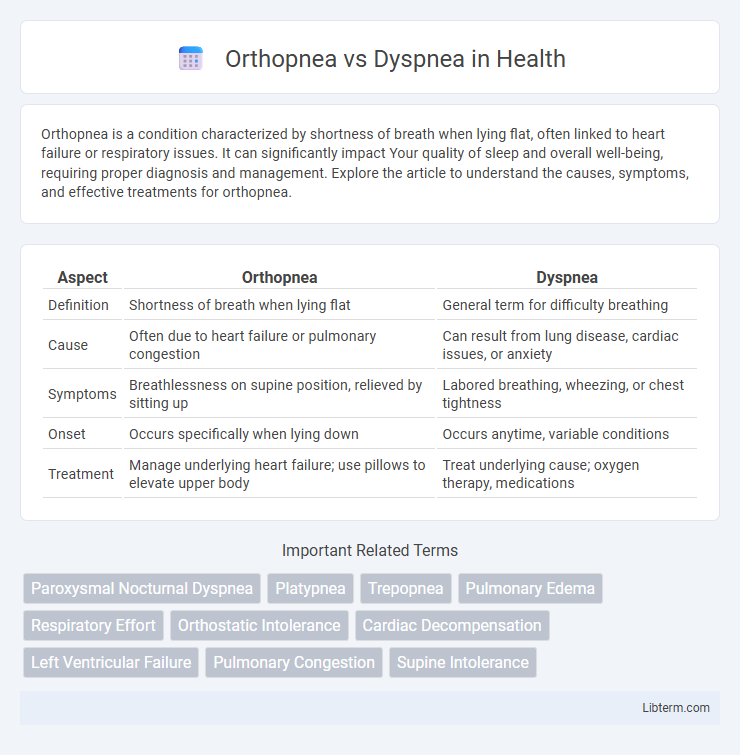Orthopnea is a condition characterized by shortness of breath when lying flat, often linked to heart failure or respiratory issues. It can significantly impact Your quality of sleep and overall well-being, requiring proper diagnosis and management. Explore the article to understand the causes, symptoms, and effective treatments for orthopnea.
Table of Comparison
| Aspect | Orthopnea | Dyspnea |
|---|---|---|
| Definition | Shortness of breath when lying flat | General term for difficulty breathing |
| Cause | Often due to heart failure or pulmonary congestion | Can result from lung disease, cardiac issues, or anxiety |
| Symptoms | Breathlessness on supine position, relieved by sitting up | Labored breathing, wheezing, or chest tightness |
| Onset | Occurs specifically when lying down | Occurs anytime, variable conditions |
| Treatment | Manage underlying heart failure; use pillows to elevate upper body | Treat underlying cause; oxygen therapy, medications |
Introduction to Orthopnea and Dyspnea
Orthopnea is a condition characterized by difficulty breathing when lying flat, commonly linked to heart failure and pulmonary congestion. Dyspnea refers to the general sensation of breathlessness or labored breathing, which can result from various cardiac, pulmonary, or systemic disorders. Understanding the distinct triggers and clinical presentations of orthopnea and dyspnea is essential for accurate diagnosis and targeted treatment.
Defining Orthopnea: Key Symptoms
Orthopnea is characterized by difficulty breathing when lying flat, often relieved by sitting or standing up, commonly associated with heart failure or pulmonary conditions. Key symptoms include shortness of breath specifically in the supine position, need for multiple pillows to sleep comfortably, and a sensation of suffocation during recumbency. Unlike dyspnea, which refers broadly to general shortness of breath, orthopnea specifically denotes positional respiratory distress linked to underlying cardiovascular or respiratory dysfunction.
Understanding Dyspnea: Main Features
Dyspnea is characterized by an uncomfortable awareness of breathing difficulty, often described as shortness of breath, which can occur at rest or during exertion. It is commonly associated with conditions such as chronic obstructive pulmonary disease (COPD), asthma, heart failure, and pulmonary embolism, with symptoms including rapid breathing, chest tightness, and use of accessory muscles for respiration. Unlike orthopnea, which specifically refers to dyspnea occurring when lying flat and improves upon sitting up, dyspnea encompasses a broader range of respiratory distress sensations independent of body position.
Distinguishing Orthopnea from Dyspnea
Orthopnea is a specific type of dyspnea characterized by shortness of breath that occurs when lying flat and improves upon sitting or standing. Dyspnea, a broader term, refers to the general sensation of breathlessness or difficulty breathing, which can occur in various positions and due to multiple causes. Clinically, orthopnea is a key indicator of congestive heart failure or left ventricular dysfunction, distinguishing it from other forms of dyspnea caused by pulmonary, neurological, or metabolic conditions.
Common Causes of Orthopnea
Orthopnea is the uncomfortable sensation of breathlessness when lying flat, commonly caused by left-sided heart failure, pulmonary edema, and severe chronic obstructive pulmonary disease (COPD). Unlike general dyspnea, which can occur in various positions due to a wide range of cardiopulmonary disorders, orthopnea specifically signals fluid redistribution or impaired cardiac function when supine. Accurate differentiation between orthopnea and dyspnea aids in diagnosing heart failure severity and managing conditions like mitral valve disease and obesity-related respiratory issues.
Common Causes of Dyspnea
Dyspnea, or shortness of breath, often results from conditions like chronic obstructive pulmonary disease (COPD), asthma, heart failure, and pulmonary embolism, whereas orthopnea specifically refers to difficulty breathing when lying flat, commonly linked to left-sided heart failure. Pulmonary infections, anemia, and obesity also contribute significantly to the onset of dyspnea. Understanding these causes is crucial for differentiating between orthopnea and general dyspnea in clinical diagnosis and treatment.
Diagnostic Approaches: Orthopnea vs Dyspnea
Orthopnea diagnosis primarily involves patient history evaluation focusing on the number of pillows used during sleep and assessing symptoms related to heart failure. Dyspnea diagnosis requires a comprehensive approach, including pulmonary function tests, chest X-rays, and arterial blood gas analysis to identify underlying respiratory or cardiovascular causes. Both conditions benefit from echocardiography and detailed clinical examination to differentiate cardiac from pulmonary origins effectively.
Treatment Options for Orthopnea
Treatment options for orthopnea primarily include addressing underlying heart failure through the use of diuretics, ACE inhibitors, and beta-blockers to reduce fluid overload and improve cardiac function. Supplemental oxygen therapy and positional adjustments, such as elevating the head during sleep, can alleviate breathing difficulties. In severe cases, mechanical ventilation or advanced therapies like continuous positive airway pressure (CPAP) may be necessary to support respiratory function.
Management Strategies for Dyspnea
Management strategies for dyspnea emphasize identifying and treating underlying causes such as heart failure, chronic obstructive pulmonary disease (COPD), or asthma. Pharmacologic interventions include bronchodilators, corticosteroids, and opioids to reduce respiratory distress. Non-pharmacologic approaches such as pulmonary rehabilitation, oxygen therapy, and breathing exercises also play a critical role in improving patient comfort and function.
Prognosis and When to Seek Medical Help
Orthopnea, characterized by difficulty breathing when lying flat, often indicates underlying heart failure and requires prompt evaluation to prevent worsening prognosis. Dyspnea, or shortness of breath, can stem from cardiac, pulmonary, or systemic causes, making timely medical assessment critical for identifying life-threatening conditions such as chronic obstructive pulmonary disease or pulmonary embolism. Immediate medical help is necessary if orthopnea or dyspnea worsens rapidly, is accompanied by chest pain, cyanosis, or altered consciousness, as these signs suggest severe or potentially fatal complications.
Orthopnea Infographic

 libterm.com
libterm.com